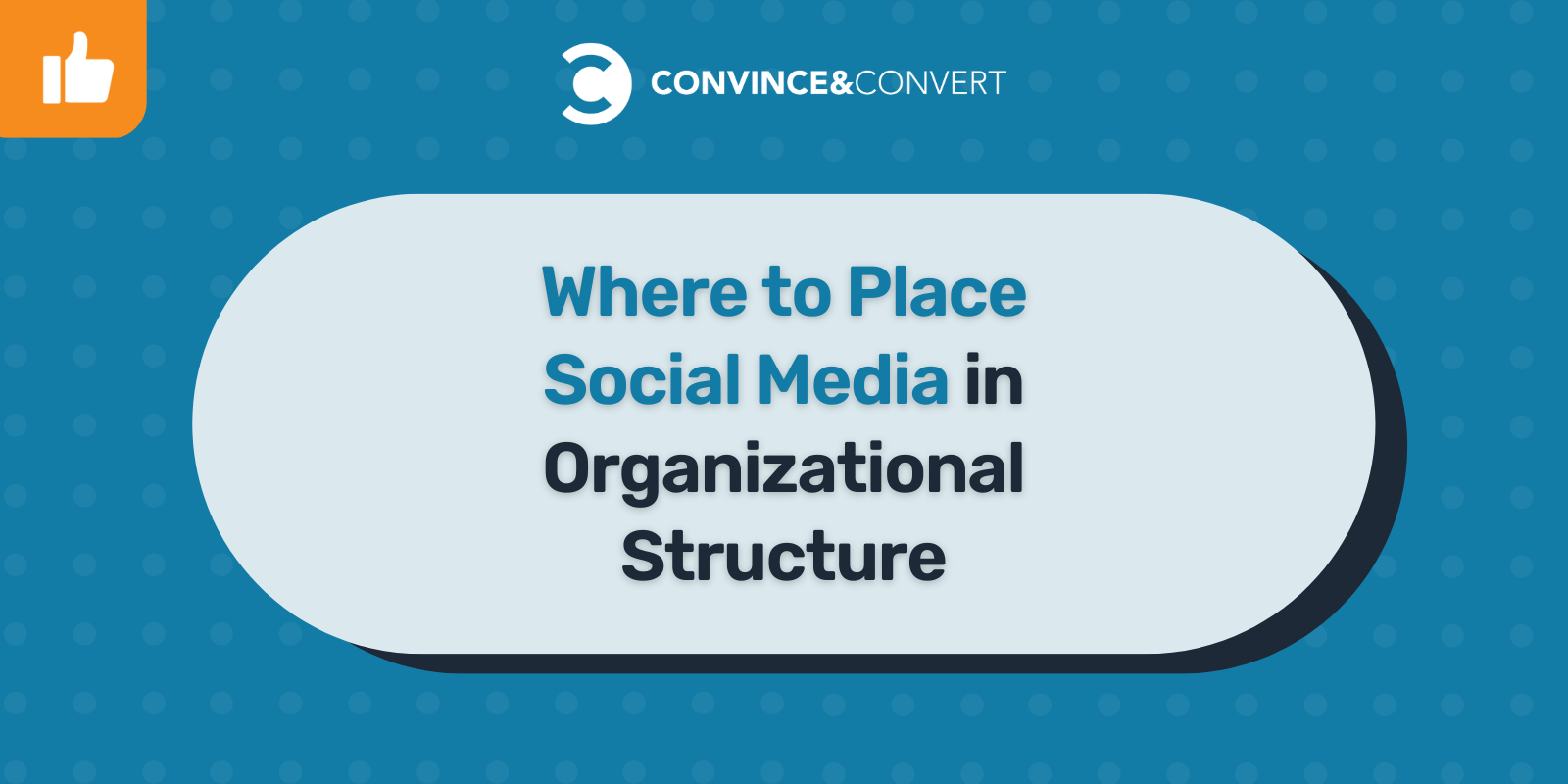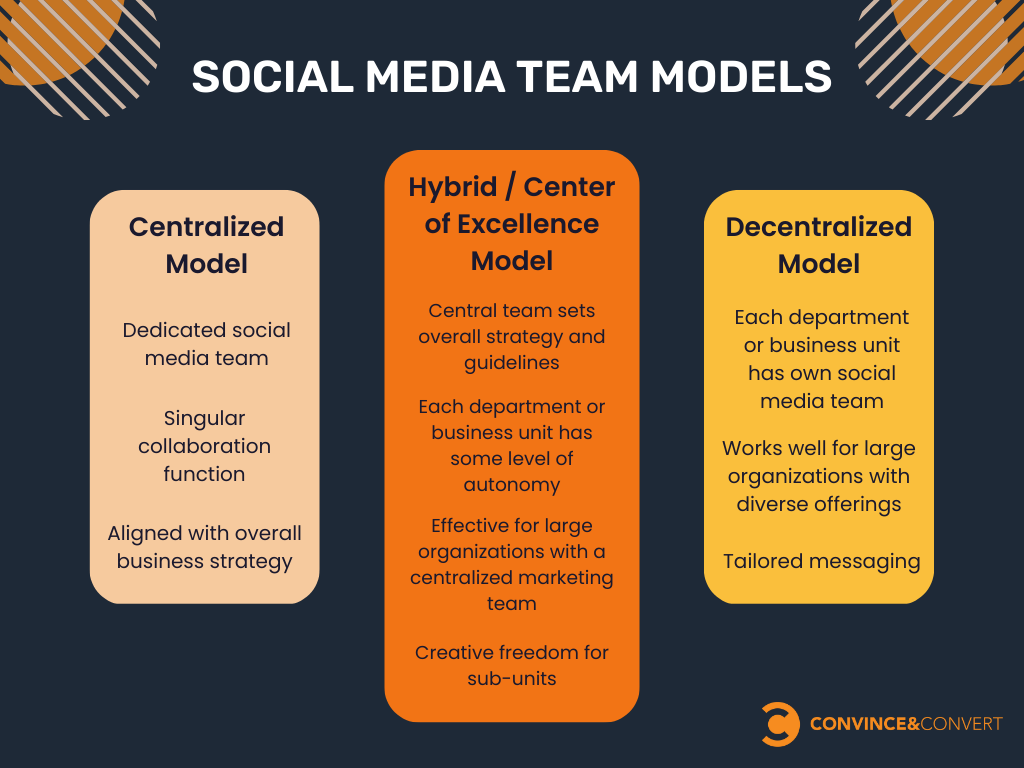
In the midst of an indecisive economy, 2023 is already riddled with re-orgs, layoffs, and structural considerations to better use internal resources. We’re also seeing organizations outsourcing specific functions or entire channel operations.
While this is an unfortunate reality, we also know that social media is more important than ever — whether in increasing discovery of a brand, nurturing existing clients for retention, or creating community to serve your most loyal customer segments. Thankfully, brands recognize this, too, and are continuing to fuel the content beast that is social media even through changes and tightening of purse strings.
Even at the enterprise level, we see teams of +100 people dedicated to social media and teams with 3 people dedicated to social media. Both can drive results and be profitable for the organization, but how do you plan for where social media fits into the organizational structure of the business?
As you consider where social media should live within your organization, whether you are cutting back or scaling up, there are a few things to keep in mind to ensure social media supports and is supported by the organization’s marketing approach. Social media strategy is C&C’s bread and butter, so we’re sharing some insights to help business leaders through uncertain times.
What Function Should Social Media Report Into?
Especially in organizations where influencers play a big role in social media or there is a heavier than average demand for crisis / issues management, we sometimes discover that C&C clients have nestled social media under a PR operation.
Other times, typically in the B2B space where social selling is a key performance indicator for social media efforts, the social team might sit within the sales team. However, through our years of experience, we have found that social media is best served under the marketing communications team, simply due to the connectivity with other owned channels and distribution tactics.
When social gets isolated from other owned distribution channels, it creates breakage in an integrated strategy. No matter how robust that social strategy is, we usually see it get the most momentum when it sits organizationally with the other marketing distribution channels. That way, they are working under the same objectives and aligning audiences, and getting better use of cross-channel opportunities.
What If We Have a Communications Team and a Marketing Team?
If you are a small or medium sized business, this is likely not relevant for you because you don’t have the need for both functions. But in complex organizational structures, there might be a comms team, a marketing team, and a brand experience team, all of which would have relevant points for why social might sit within their division.
On a most-basic level, we lean toward the marketing team because that is typically where owned channel teams sit (think: email / SMS marketing, app team leads, website content, etc). Ultimately, social media is simply another distribution channel and as such should be collaborating with all the content marketing channels. If it’s not that clear-cut for your team, we have some key considerations you should ask to determine where social sits:
- Who is the audience?
- What team is creating and distributing content directly to that audience?
- What’s the role and goal of social?
- Where does social best serve in your marketing / sales funnel?
With these inputs, you can make a case for where social media is going to be most effective in a customer’s journey and ensure maximum connectivity to the end audience through an integrated channel plan.
What Other Considerations Should We Take into Account?
-
Hurdle #1: Organizational Placement Based on Skill Set
“Who understands social media?” is a business-level question that often leads to a reorg of where a social team sits and what function the team reports into. Would this happen with an IT team? Oh, Joe over in sales actually really loves IT. Let’s have the IT team report to him! No, this would never happen. But it happens ALL THE TIME with social media teams, and leads to really wonky, displaced, and ineffective social media functions.
Our C&C consultants spend hundreds of hours a year untangling wrongfully placed social teams within organizational structures. Here’s how to save yourself time and resourcing issues down the road: social media should sit on a content marketing team, and that content marketing team should be inter-connected with all owned channel distribution methods, including paid media.
-
Hurdle #2: Avoiding Silos
Decentralized marketing organizations traditionally have placed social media strategy and management within business verticals (i.e., there’s a B2B social team with their own handles and a separate B2C social team with their own channels – both report to those business units). This type of structure can be beneficial for speed to publish as well as expertise.
However, hybrid or centralized models are giving organizations the opportunity to see cross-vertically and audience-first, with the added benefit of getting more use out of assets across social channels. That’s what we’re spending our time doing in 2023 — de-siloing internal social media teams. How can you decide what’s best for your organization?
- Centralized organizations have a dedicated social media team that is responsible for creating and implementing social media strategy across all channels and business verticals. This enables a central team to define voice, tone, brand guidelines, and creative resourcing while also having a singular collaboration function with other departments, including marketing, PR, customer service, and product development, to ensure that social media is aligned with the overall business strategy.
- Decentralized models allow each department or business unit to have its own social media team or person responsible for managing their respective social media channels. This can work well for large organizations with diverse offerings, as each department can tailor its messaging and approach to its unique audience.
- Examples – regional businesses (car companies with different global locations), B2B2C hybrids (one social for B2B, one for B2C audiences), higher ed (colleges within the universities run their own content strategies for social)
- A Hybrid / Center of Excellence model establishes a central social media team to set the overall strategy and guidelines, but each department or business unit has some level of autonomy to adapt the strategy to their needs. A COE model can be effective for large organizations with a centralized marketing team that can provide guidance and best practices, but still allow sub-units a level of creative freedom. Most often, we recommend a COE model when there is a need for centralization, but the divisions of the business are simply too vast for one team to strategize, implement and resource.

-
Hurdle #3: Outsourcing vs. In-house Resourcing
Social media agencies are a dime a dozen, from full service strategy to execution to specialties within social media such as influencer management. This can be a cost-effective way to manage the demands of social media, especially for smaller organizations or business units that don’t have the resources to hire a full-time social media team.
Our caution here is to make sure you have a very stable and collaborative internal person or group managing the relationship(s) to ensure connectivity to the marketing goals, collaboration with the other channel teams, and integrated reporting that powers your overarching content marketing decision making.
One element that can be beneficial to outsource is atomization of content to distribute cross-channel, i.e., a creative partner that can help the social team to maximize resources created by other teams within the organization such as thought leadership.
-
Hurdle #4: Integrated Content Planning
A common theme we find in our strategy work with social teams is ineffective cross-channel planning and inefficient use of existing creative. Marketing demands content, and in today’s world of personalization and customization, that demand is only increasing. So how do you keep it affordable and profitable for your business?
The answer is integrated channel planning and atomization of content across distribution channels. This connects back to de-siloing social teams (hurdle #1), but helps teams to stretch beyond just social collaboration across the business. You must break down silos across your marketing organization to get the most ROI out of content creation.
Additionally, de-silo content plans across thought leadership, enterprise / brand level priorities, and product innovation or R&D to ensure the social and content teams have visibility and can maximize those resources across audiences and platforms.
The COE and centralized structural models will have a big impact for content planning and efficient use of content resources – it’s an innate feature of the structures. Just make sure it extends across marketing functions beyond just social media.
How Do I Show the Value of Social Media?
If you are finding that social media resourcing and creative costs are on the chopping block in 2023, you must find ways to connect your social content strategy to business-level impact.
A 2023 report from WordPress found that 9 in 10 content marketing teams with leadership buy-in have revenue goals tied to content. At the same time, content marketers still struggle with how to track ROI of content – especially when it comes to proving the value of content in the sales funnel.
Additionally, marketers are not using content analytics to make strategy moves. Most are measuring content and channel performance due to the increased pressure on KPIs, but they aren’t then using the learnings to shift their approach.
Check out our blog on how to measure your social media ROI for a breakdown on the importance of measuring your social media KPIs, what metrics are most important, how to prove social media ROI, the challenges you might face, and the best practices to improve your social media ROI.
Want assistance and further insight for your team? Let us help you with your social media structural strategy.



